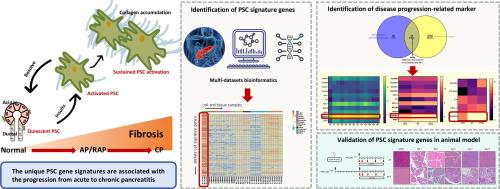Computational and Structural Biotechnology Journal ( IF 6 ) Pub Date : 2021-11-26 , DOI: 10.1016/j.csbj.2021.11.031 Cheng Hu 1 , Liyuan Yin 2 , Zhiyao Chen 1 , Richard T Waldron 3, 4 , Aurelia Lugea 3, 4 , Yiyun Lin 5 , Xiaoqian Zhai 2 , Li Wen 6 , Yuan-Ping Han 7 , Stephen J Pandol 3, 4 , Lihui Deng 1 , Qing Xia 1

|
Chronic pancreatitis (CP) is characterized by irreversible fibro-inflammatory changes induced by pancreatic stellate cell (PSC). Unresolved or recurrent injury caused dysregulation of biological process following AP, which would cause CP. Here, we systematically identify genes whose expressions are unique to PSC by comparing transcriptome profiles among total pancreas, pancreatic stellate, acinar, islet and immune cells. We then identified candidate genes and correlated them with the pancreatic disease continuum by performing intersection analysis among total PSC and activated PSC genes, and genes persistently differentially expressed during acute pancreatitis (AP) recovery. Last, we substantiated candidate genes potential as biomarkers in experimental AP and recurrent AP (RAP) models. A total of 68 genes were identified as highly and uniquely expressed in PSC. The PSC signatures were highly enriched with extracellular matrix remodeling and were significantly enriched in AP pancreas compared to healthy control tissues. Among PSC signature genes that comprised a fibrotic phenotype, 10 were persistently differentially expressed during AP recovery. SPARC was determined as a candidate marker for the pancreatic disease continuum, which was not only persistently differentially expressed even five days after AP injury, but also highly expressed in two clinical datasets of CP. Sparc was also validated as highly elevated in RAP compared to AP mice. This work highlights the unique transcriptional profiles of PSC. These PSC signatures’ expression may help to identify patients with high risk of AP progression to CP.
中文翻译:

独特的胰腺星状细胞基因表达特征与从急性到慢性胰腺炎的进展有关
慢性胰腺炎 (CP) 的特征是由胰腺星状细胞 (PSC) 诱导的不可逆的纤维炎症变化。未解决或复发性损伤导致 AP 后生物过程的失调,这将导致 CP。在这里,我们通过比较总胰腺、胰腺星状细胞、腺泡、胰岛和免疫细胞之间的转录组谱,系统地识别出其表达对 PSC 独特的基因。然后,我们通过对总 PSC 和激活的 PSC 基因以及在急性胰腺炎 (AP) 恢复期间持续差异表达的基因进行交叉分析,确定候选基因并将它们与胰腺疾病连续体相关联。最后,我们证实了候选基因在实验性 AP 和复发性 AP (RAP) 模型中作为生物标志物的潜力。共有 68 个基因被鉴定为在 PSC 中高度且独特地表达。与健康对照组织相比,PSC 特征在细胞外基质重塑中高度富集,并且在 AP 胰腺中显着富集。在包含纤维化表型的 PSC 特征基因中,10 个在 AP 恢复期间持续差异表达。SPARC 被确定为胰腺疾病连续体的候选标志物,它不仅在 AP 损伤后 5 天也持续存在差异表达,而且在 CP 的两个临床数据集中也高度表达。与 AP 小鼠相比,Sparc 也被证实在 RAP 中高度升高。这项工作突出了 PSC 独特的转录谱。这些 PSC 特征的表达可能有助于识别 AP 进展为 CP 的高风险患者。与健康对照组织相比,PSC 特征在细胞外基质重塑中高度富集,并且在 AP 胰腺中显着富集。在包含纤维化表型的 PSC 特征基因中,10 个在 AP 恢复期间持续差异表达。SPARC 被确定为胰腺疾病连续体的候选标志物,它不仅在 AP 损伤后 5 天也持续存在差异表达,而且在 CP 的两个临床数据集中也高度表达。与 AP 小鼠相比,Sparc 也被证实在 RAP 中高度升高。这项工作突出了 PSC 独特的转录谱。这些 PSC 特征的表达可能有助于识别 AP 进展为 CP 的高风险患者。与健康对照组织相比,PSC 特征在细胞外基质重塑中高度富集,并且在 AP 胰腺中显着富集。在包含纤维化表型的 PSC 特征基因中,10 个在 AP 恢复期间持续差异表达。SPARC 被确定为胰腺疾病连续体的候选标志物,它不仅在 AP 损伤后 5 天也持续存在差异表达,而且在 CP 的两个临床数据集中也高度表达。与 AP 小鼠相比,Sparc 也被证实在 RAP 中高度升高。这项工作突出了 PSC 独特的转录谱。这些 PSC 特征的表达可能有助于识别 AP 进展为 CP 的高风险患者。



























 京公网安备 11010802027423号
京公网安备 11010802027423号